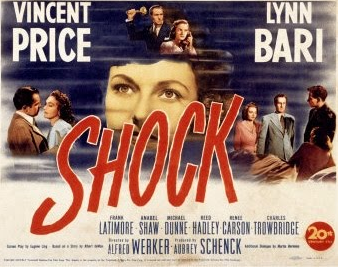Shock

Main Credits
Director: Alfred Werker. Screenplay: Eugene Ling from a story by Albert DeMond. Producer: Aubrey Schenck. Directors of Photography: Joe MacDonald and Glen MacWilliams. Music: David Buttolph. Art Directors: Boris Leven and Lyle Wheeler. Editor: Harmon Jones. Costume Designer: Kay Nelson. Cast: Vincent Price (Dr. Richard Cross), Lynn Bari (Elaine Jordan), Frank Latimore (Lt. Paul Stewart), Anabel Shaw (Janet Stewart), Michael Dunne (Dr. Stevens), Reed Hadley (O’Neill), Renee Carson (Mrs. Hatfield), Charles Trowbridge (Dr. Franklin Harvey). Released: Twentieth Century Fox, January 10, 1946. 70 minutes.
From Film Noir: The Encyclopedia
Plot Summary
Janet is anxiously waiting in a hotel room for her husband, Paul, an ex-P.O.W. she hasn’t seen for two years. After awakening from a nightmare about Paul, she witnesses Richard bludgeon his wife to death. The next day Paul arrives and finds Janet catatonic. Richard, a psychiatrist staying at the hotel, is asked to evaluate Janet’s condition. Realizing she must have seen the murder and gone into shock, Richard takes her to his sanatorium. To prevent her from recovering, Richard and his mistress, Elaine, secretly try to drive Janet insane. Paul asks Dr. Harvey for a second opinion, but he sees nothing wrong. Richard makes his wife’s death look like a fall onto rocks near his lodge. O’Neill, investigating another crime near the lodge, has the wife’s body exhumed for autopsy and discovers how she was killed. With O’Neill closing in, Richard and Elaine start to kill Janet with an overdose of insulin. Richard can’t go through with it, and he kills Elaine when she tries to make him complete the fatal injection. Paul convinces Dr. Harvey that Janet’s in grave danger, and they get to the sanatorium in time.
Commentary
By 1946, the woman in distress and the femme fatale were frequently appearing in film noirs. Shock, however, is distinctive for having both together. In an unusual triangle, Elaine, the femme fatale, is not only responsible for Richard’s downfall but also for making Janet the woman in distress.
In both scenes where Richard and Elaine are at his house, he regrets “listening” to her and not calling the police after he killed his wife. In the first scene, he resists when she urges him not to allow Janet’s shock “to wear off.” He wants “to think” about it. But when she takes his arms and comes close to him, it is understood that she will get her way. In the second scene, Elaine says they should “take care of” Janet so she can’t be interviewed by the police. Richard is unwilling to give Janet a lethal injection, and Elaine criticizes him for being weak. Then, with the gentlest of manner, she tries seduction.
In other scenes Richard and Elaine spar over which of them correctly “sees” what’s going on. Their relationship is less about romance than the extent to which he is under her sway. That Elaine, a nurse, has such power over Richard, a specialist, shows there are factors, like sexual attraction, other than expertise or a position of authority that determine which of two people is in charge.
There are other instances in Shock, however, when the person with higher rank has the advantage, for good or ill. Janet arrives at the hotel, and the clerk tells her no room is available. The hotel manager comes out and arranges a room for her. The hotel doctor can only give a non-specialist’s evaluation of Janet, so she’s turned over to Richard. Due to his position at the sanatorium, Richard can get away with administering an overdose to Janet. Dr. Harvey, under whom Richard studied, has the prestige and confidence to barge into the sanatorium to save Janet.
Notably, the film doesn’t end with Janet’s rescue and, at long last, her reunion with Paul. Instead, the final scene is of Richard being led away by O’Neill. Psychiatry and criminology represent other types of expertise and authority. Dr. Harvey tells Paul, “You realize it’s hard to make generalizations,” because psychiatry is not an exact science. The police, in contrast, use scientific methods and instruments. For O’Neill, determining the murder weapon is a silver candlestick is, “Just routine.” In Shock, criminology is counter-posed to psychiatry and outclasses it.
The layout of Janet’s hotel room foreshadows Richard’s sanatorium. The room has two small classical columns, set some distance apart from each other in front of the door to the hallway. In the common area on one floor of the sanatorium, there are two large classical columns, set similarly apart and in front of a door. Also, Janet’s nightmare at the hotel, in which she and Paul cannot find one another, foreshadows her confinement in the sanatorium, with its empty white hallways and Paul struggling to be with her.